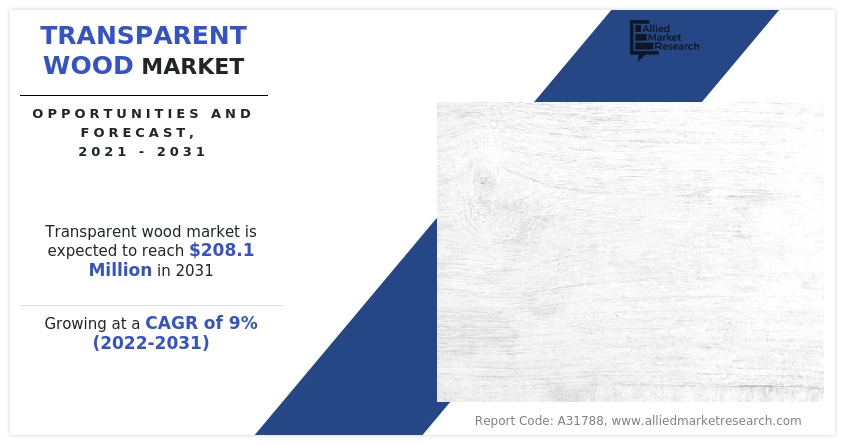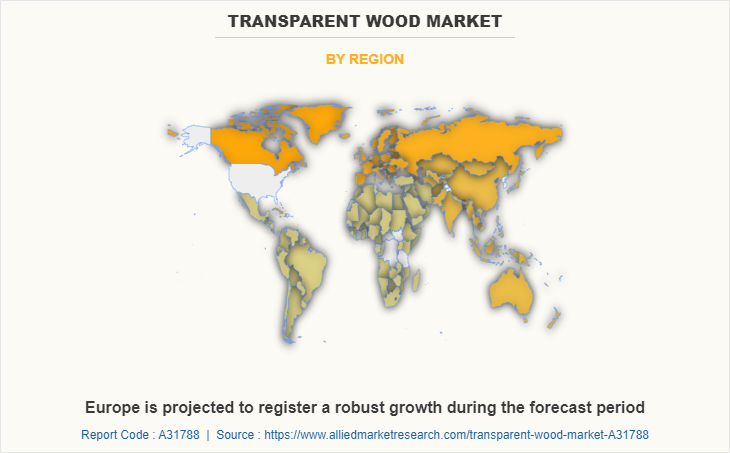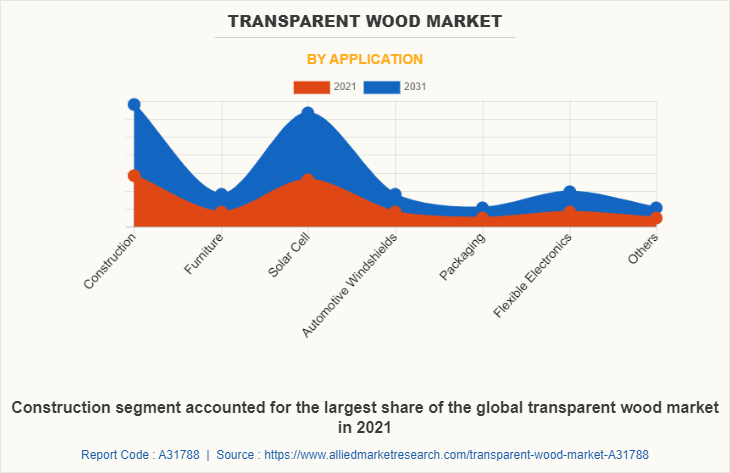Transparent Wood Market Research, 2031
The global transparent wood market size was valued at $88.4 million in 2021, and is projected to reach $208.1 million by 2031, growing at a CAGR of 9.0% from 2022 to 2031.
Report Key Highlighters:
- The transparent wood market study covers 20 countries. The research includes a segment analysis of each country in terms of value ($million) for the projected period 2021-2031.
- More than 3,700 product literatures, annual reports and other comparable materials from key industry participants were studied in order to gain a better understanding of the transparent wood market.
- The transparent wood market is highly consolidated, with few players including Abro, Cellutech AB, DEFY, Hoffmann Mineral GmbH, Holland Composites, InventWood, Nomaco, Preserva Products LTD., Sayerlack, and Wash Safe. Also tracked key moves and developments including acquisitions, mergers, product launches, expansion etc. of the players operating in the market.

Transparent wood is one of the innovative construction materials, which is environment-friendly and an excellent alternative to glass and plastics used for producing see-through packaging, car windshields, and biomedical devices. Transparent wood is also cost-efficient as is five times more efficient than glass thereby cutting energy cost. It is manufactured by treating as well as compressing wood strips. During the manufacturing process, lignin is replaced by polymers in order to make the wood transparent. It is lighter, stronger than glass, and has the same strength of lumber.
Rise in use of transparent wood from various applications such as construction, furniture, solar cell, car windshields, see-through packaging and others is expected to serve as a crucial growth factor for the global transparent wood market growth.
Transparent wood is widely used in end-use industries such as construction, furniture, solar cell, and others. It can replace steel and stone in construction owing to its properties such as strength and lightweight. Transparent wood may be used as a primary structural element since it is lighter than steel, but also showcases high strength with the addition of the polymers and epoxies. Transparent wood roofs can be used in certain buildings for offering uniform illumination as compared to glass. It offers a superior way for builders to bring more light into their construction projects.
Besides, panels can be produced from transparent wood which offers better impact strength, lower thermal conductivity, and lower density as compared to glass. This wood is also used as a transparent structural material for some of photovoltaic devices including solar cells and electrochromic devices. Functionalized transparent wood is extensively used for construction of smart buildings. Transparent wood attains diffused luminescence properties by incorporation of quantum dots and can be utilized in luminescent building elements, planar light sources, or designed furniture.
Moreover, transparent wood is utilized for heat storage. It is used as an encapsulating material for preventing the leakage of the phase change material. Wood has an ideal structure since it has nano porosity, consequently, it works extremely well in order to retain the phase change material from leaking out. The transparent wood can efficiently absorb heat, store it, and release it whenever required. Further, high-end sports equipment including, tennis rackets, archery bows, various sticks and clubs, etc. are made of transparent wood. It is a popular choice of material for wings and fuselages for small aircraft.
However, vulnerability of transparent wood to water damage is anticipated to hamper the growth of the global transparent wood industry. On the contrary, surge in demand for sustainable building materials is expected to generate lucrative opportunities for the growth of the global transparent wood market. As per the study Science of The Total Environment, transparent wood helps lessen ecological impacts on the environment owing to its biodegradable and renewable properties. Further, according to the UN Environment Program, the world currently produces about 400 million tons of plastic waste annually, with rising levels of single-use plastic which is used and then discarded. In recent years, transparent wood is emerging as one of the most promising substitute materials of the future. Transparent wood can replace the environmentally harmful petroleum-based plastics including, polyvinyl chloride (PVC), polypropylene, acrylic, polyethylene, and others.
Research & Development
Rise in demand for sustainable optical materials has led to numerous research and development related to transparent wood. In 2021, The University of Maryland did research and uncovered a process which consists of using lignin as a binder in order to offer a scaffold for polymer infiltration, that includes benefits including, reducing processing time and decreasing chemical and energy consumption. With this research, energy-efficient transparent wood nearly one millimeter in thickness was produced. It had high haze, transmittance, and a high level of light-guiding effect over visible wavelength. This wood transparency process is highly effective and scalable.
The transparent wood market is segmented into application and region. On the basis of application, the market is categorized into construction, furniture, solar cell, automotive windshields, packaging, flexible electronics, others. The construction segment dominated the global transparent wood market in 2021. Region-wise, the transparent wood market share is studied across North America, Europe, Asia-Pacific, and LAMEA. Europe is projected to register robust growth during the forecast period. Transparent wood is environment-friendly due to its inherent capacity to retain carbon and support low-carbon lifestyles. It takes the benefits of timber one step further, with its unique thermal-insulation abilities in Europe. Transparent wood is primarily used in the packaging industry in Europe because it has good oxygen resistance, water absorption, and biodegradability.
The major players operating in the global transparent wood market include Abro, Cellutech AB, DEFY, Hoffmann Mineral GmbH, Holland Composites, InventWood, Nomaco, Preserva Products LTD., Sayerlack, and Wash Safe.

Europe is projected to register a robust growth during the forecast period. Transparent wood is primarily used in the packaging industry in Europe because it has good oxygen resistance, water absorption, and biodegradability. According to the World Food and Agriculture, the UK consumed 9.9 million metric tons of paper and board, with packaging accounting for 5.6 million metric tons, accounting for more than half of total paper and board consumption in 2020.
As per the Germany Works, Germany is Europe’s biggest construction market, with the continent’s largest building stock. The industry’s revenues increased by 5.9% to €143 ($175.6) billion in 2020 where transparent wood is also being used in the furniture and construction industries, such as load bearing window door frames and columns. This has raised the demand for vendors to produce sustainable and recyclable transparent wood packaging. Thus, the increasing demand for packaging and construction is expected to boost the market of transparent wood during the forecast period.

The construction segment accounted for the largest share of the global transparent wood market in terms of revenue, in 2021. Transparent wood is utilized in the residential, office, retail, hotel, and leisure park real estate segments, among others where the urban development section is divided into sub-segments like urban transportation, schools, and healthcare. Transparent wood is one of the creative building materials with the ability to take the construction industry to a whole new level. It is used in home building to let more light into the dwelling. It may be used as an encapsulating material to prevent heat leakage from the phase change material, which can absorb, store, and release heat as needed. When the temperature rises over 30 degrees Celsius, the transparent wood absorbs heat and releases it once it begins to cool.
Transparent wood will provide an excellent way for builders to bring more light into their construction projects. It is useful for more than just support pillars. By selecting separating transparent wood lignin that supports walls and substituting it with a certain type of polymer, transparent wood that is in high demand in the building sector is created. Rise in commercial construction in Canada can hugely benefit from the transparent wood sector where better insulation property being used in building tall towers.
Key Benefits For Stakeholders
- This report provides a quantitative analysis of the market segments, current trends, estimations, and dynamics of the transparent wood market analysis from 2021 to 2031 to identify the prevailing transparent wood market opportunities.
- The market research is offered along with information related to key drivers, restraints, and opportunities.
- Porter's five forces analysis highlights the potency of buyers and suppliers to enable stakeholders make profit-oriented business decisions and strengthen their supplier-buyer network.
- In-depth analysis of the transparent wood market segmentation assists to determine the prevailing market opportunities.
- Major countries in each region are mapped according to their revenue contribution to the global market.
- Market player positioning facilitates benchmarking and provides a clear understanding of the present position of the market players.
- The report includes the analysis of the regional as well as global transparent wood market trends, key players, market segments, application areas, and market growth strategies.
Transparent Wood Market Report Highlights
| Aspects | Details |
| Market Size By 2031 | USD 208.1 million |
| Growth Rate | CAGR of 9% |
| Forecast period | 2021 - 2031 |
| Report Pages | 150 |
| By Application |
|
| By Region |
|
| Key Market Players | Hoffmann Mineral GmbH, Sayerlack, Wash Safe, InventWood, Cellutech AB, Preserva Products LTD., DEFY, Nomaco, Holland Composites, Abro |
Analyst Review
According to the perspective of the CXOs of leading companies, the transparent wood market is anticipated to grow in the near future due to its extensive use in applications, such as construction, furniture, solar cell, automotive windshields, packaging, flexible electronics, and others.
There is surge in investments by the government in infrastructure growth across the globe, which is likely to propel the demand for transparent wood in the coming years. Besides, there are various construction projects initiated by the government globally, especially in the urban areas.
The development of new infrastructure and development projects is increasing globally owing to the rise in population, which is requiring the construction of new hotels, hospitals, schools, office buildings, education centers, colleges, and other public buildings. Further, the Europe region is projected to register a robust growth during the forecast period.
The global transparent wood market size was valued at $88.4 million in 2021, and is projected to reach $208.1 million by 2031, growing at a CAGR of 9.0% from 2022 to 2031.
Rise in use of transparent wood from various applications such as construction, furniture, solar cell, car windshields, see-through packaging and others is expected to serve as a crucial growth factor for the global transparent wood market. Surge in construction activities is another key factor that fosters the market growth during the forecast period.
Construction is the leading application of Transparent Wood Market.
Asia-Pacific is the fastest growing region for Transparent Wood.
Top companies to hold the market share in Transparent Wood include Abro, Cellutech AB, DEFY, Hoffmann Mineral GmbH, Holland Composites, InventWood, Nomaco, Preserva Products LTD., Sayerlack, and Wash Safe.
Loading Table Of Content...



